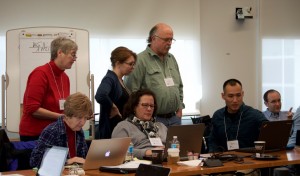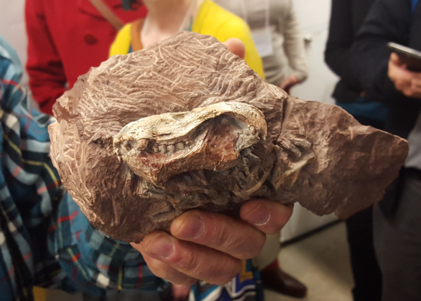The Internet of Things may be all the rage, but a group of scientists that met recently at the Renaissance Computing Institute (RENCI) wants to add the Internet of Samples (iSamples) to your radar.

A multidisciplinary group of scientists and researchers brainstorm potential elements of the iSamples action plan for the coming year.
Across the world, scientists engage in research that requires them to collect physical samples, which are often unique and difficult to acquire. Think of samples from the moon, core samples of the Earth, or those collected by submersibles sent to the depths of the ocean.
Not only are these samples difficult to obtain, but once gathered, they often remain in the possession of individual scientists or institutions. Such barriers mean most research based on those samples happens in isolation, something Kerstin Lehnert, iSamples principle investigator and senior research scientist at Lamont-Doherty Earth Observatory, wants to change.
“These samples need to be preserved, and the whole science community needs to be aware that they exist so they don’t spend money and effort to go and collect the same things,” said Lehnert. “You want to build on science that has already been generated.”
iSamples, an Earthcube Research Coordination Network funded by the National Science Foundation, aims to bridge the world of physical samples with the digital world by creating a cyberinfrastructure that enables collaboration between scientific domains that use samples but may not traditionally work together.

A researcher at the NC Museum of Natural Sciences shows off a pre-mammalian fossil from about 230 million years ago.
The iSamples team focuses on three areas: 1) the creation of unique identifiers for samples, similar to the Digital Object Identifier (DOI) system already widely in use; 2) a unified metadata standard that accounts for the different sample types gathered across disciplines; and 3) general outreach to communicate the benefits of a universal and systematic method of sharing sample information.
The International Geo Sample Number (IGSN) offers a potential solution for creating unique identifiers. The nine-digit alphanumeric code uniquely identifies samples from the natural environment, and researchers can already obtain an IGSN by registering samples in the System for Earth Sample Registration (SESAR).
For the IGSN to be successful, a wide range of communities including museums, repositories, and relevant scientific domains should register their samples. Additionally, the IGSN system needs support to develop and maintain metadata standards across disciplines. The iSamples group sees addressing and overcoming these challenges as key to successful scientific discovery.
“Today’s big scientific questions are really transdisciplinary,” said Chris Lenhardt, a domain scientist in Environmental Data Science and Systems at RENCI and co-organizer of the workshop. “iSamples wants to provide the opportunity for scientists to bring everything together—data, images, metadata, and physical objects—and make it all accessible in a coordinated fashion to facilitate more integrated science and promote new discoveries.”
To stay in touch with iSamples progress or contribute to their efforts, visit their website and consider joining their listserv.


